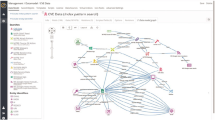Abstract
With the continuous improvement of the informatization level of the police, how to make accurate intelligence analysis based on the modeling of massive multimodal data has always been a real intricate problem during the applications of public security big data. Knowledge graph technique can fuse and marge multimodal data in public security business to different intelligence entity elements including person, thing, material, time, and position and reconstruct the deep relations among data in the digital space, which can provide computable and minable data resources with logical hierarchy for intelligence analysis. This study started from the case text data in public security domain, attempted ontology modeling for knowledge mapping in public security domain and explored the establishment mode and application direction of knowledge graphs in public security domain.




Similar content being viewed by others
REFERENCES
Li, Q., Li, F., Li, S., Li, X., Liu, K., Liu, Q., and Dong, P., Improving entity linking by introducing knowledge graph structure information, Appl. Sci., 2022, vol. 12, no. 5, p. 2702. https://doi.org/10.3390/app12052702
Shan, L., Kun, Z., and Jun-ru, S., Retrospection and prospect of embeddedness theory–knowledge map analysis based on bibliometrics, J. Data, Inf. Manage., 2022, vol. 4, no. 1, pp. 57–70. https://doi.org/10.1007/s42488-022-00067-5
Huang, H.Q., Yu, J., and Liao, X., Review on knowledge graphs, Comput. Sci. Appl., 2019, vol. 28, no. 6, pp. 1–12.
Liu, Z.Y., Research and implementation of knowledge graph mapping technology for public security intelligence analysis, MSc Thesis, Chengdu, China: Univ. of Electronic Science and Technology of China, 2019.
Pendharkar, P.C. and Bhaskar, R., A hybrid Bayesian network-based multi-agent system and a distributed systems architecture for the drug crime knowledge management, Int. J. Inf. Technol. Decision Making, 2003, vol. 2, no. 4, pp. 557–576. https://doi.org/10.1142/s0219622003000872
Keppens, J. and Schafer, B., Knowledge based crime scenario modelling, Expert Syst. Appl., 2006, vol. 30, no. 2, pp. 203–222. https://doi.org/10.1016/j.eswa.2005.07.011
Phillips, P. and Lee, I., Mining top-k and bottom-k correlative crime patterns through graph representations, 2009 IEEE Int. Conf. on Intelligence and Security Informatics, Richardson, Tenn., 2009, IEEE, 2009, pp. 25–30. https://doi.org/10.1109/isi.2009.5137266
Elezaj, O., Yayilgan, S.Y., Kalemi, E., Wendelberg, L., Abomhara, M., and Ahmed, J., Towards designing a knowledge graph-based framework for investigating and preventing crime on online social networks, E-Democracy–Safeguarding Democracy and Human Rights in the Digital Age. e-Democracy 2019, Katsikas, S. and Zorkadis, V., Eds., Communications in Computer and Information Science, vol. 1111, Cham: Springer, 2019, pp. 181–195. https://doi.org/10.1007/978-3-030-37545-4_12
Zhang, W.X. and Zhu, Q.H., Research on semi-automatic domain ontology construction, Libr. Inf., 2011, no. 1, pp. 16–19.
Zhao, M., Qin, H.P., Zhang, G.X., Lyu, Y.J., and Zhu, Y., TermTree and Knowledge Annotation Framework for Chinese Language Understanding, TR: 2020-KG-TermTree, Baidu, 2020.
Dozat, T. and Manning, C.D., Deep biaffine attention for neural dependency parsing, Proc. 5th Int. Conf. on Learning Representations, Toulon, France, 2017, Association for Computational Linguistics, 2017. https://openreview.net/forum?id=Hk95PK9le.
Chang, P.-Ch., Tseng, H., Jurafsky, D., and Manning, C.D., Discriminative reordering with Chinese grammatical relations features, Proc. Third Workshop on Syntax and Structure in Statistical Translation-SSST ’09, Boulder, Colo., 2009, Stroudsburg, Pa.: Association for Computational Linguistics, 2009, pp. 51–59. https://doi.org/10.3115/1626344.1626351
Su, J., SimBERT: Integrating retrieval and generation into BERT, 2020.
Funding
This study is partially supported by Jiangsu Social Science Foundation Project “Research on the Transformation of Public Security Intelligence Work Based on Big Data Technology” (19TQD004); Project on 2021 Outstanding young backbone teacher of Jiangsu Universities “Qinglan Project.”
Author information
Authors and Affiliations
Corresponding author
Ethics declarations
The authors declare that they have no conflicts of interest.
About this article
Cite this article
Qiu Mingyue, Zhang Xueying Establishment Method of Knowledge Graphs for Public Security Cases. Aut. Control Comp. Sci. 57, 543–551 (2023). https://doi.org/10.3103/S0146411623060056
Received:
Revised:
Accepted:
Published:
Issue Date:
DOI: https://doi.org/10.3103/S0146411623060056




